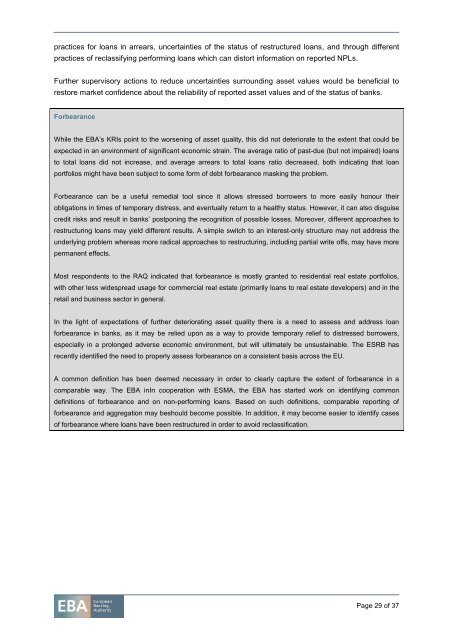EBA Long Report - European Banking Authority - Europa
EBA Long Report - European Banking Authority - Europa
EBA Long Report - European Banking Authority - Europa
Create successful ePaper yourself
Turn your PDF publications into a flip-book with our unique Google optimized e-Paper software.
practices for loans in arrears, uncertainties of the status of restructured loans, and through different<br />
practices of reclassifying performing loans which can distort information on reported NPLs.<br />
Further supervisory actions to reduce uncertainties surrounding asset values would be beneficial to<br />
restore market confidence about the reliability of reported asset values and of the status of banks.<br />
Forbearance<br />
While the <strong>EBA</strong>’s KRIs point to the worsening of asset quality, this did not deteriorate to the extent that could be<br />
expected in an environment of significant economic strain. The average ratio of past-due (but not impaired) loans<br />
to total loans did not increase, and average arrears to total loans ratio decreased, both indicating that loan<br />
portfolios might have been subject to some form of debt forbearance masking the problem.<br />
Forbearance can be a useful remedial tool since it allows stressed borrowers to more easily honour their<br />
obligations in times of temporary distress, and eventually return to a healthy status. However, it can also disguise<br />
credit risks and result in banks’ postponing the recognition of possible losses. Moreover, different approaches to<br />
restructuring loans may yield different results. A simple switch to an interest-only structure may not address the<br />
underlying problem whereas more radical approaches to restructuring, including partial write offs, may have more<br />
permanent effects.<br />
Most respondents to the RAQ indicated that forbearance is mostly granted to residential real estate portfolios,<br />
with other less widespread usage for commercial real estate (primarily loans to real estate developers) and in the<br />
retail and business sector in general.<br />
In the light of expectations of further deteriorating asset quality there is a need to assess and address loan<br />
forbearance in banks, as it may be relied upon as a way to provide temporary relief to distressed borrowers,<br />
especially in a prolonged adverse economic environment, but will ultimately be unsustainable. The ESRB has<br />
recently identified the need to properly assess forbearance on a consistent basis across the EU.<br />
A common definition has been deemed necessary in order to clearly capture the extent of forbearance in a<br />
comparable way. The <strong>EBA</strong> inIn cooperation with ESMA, the <strong>EBA</strong> has started work on identifying common<br />
definitions of forbearance and on non-performing loans. Based on such definitions, comparable reporting of<br />
forbearance and aggregation may beshould become possible. In addition, it may become easier to identify cases<br />
of forbearance where loans have been restructured in order to avoid reclassification.<br />
Page 29 of 37
















